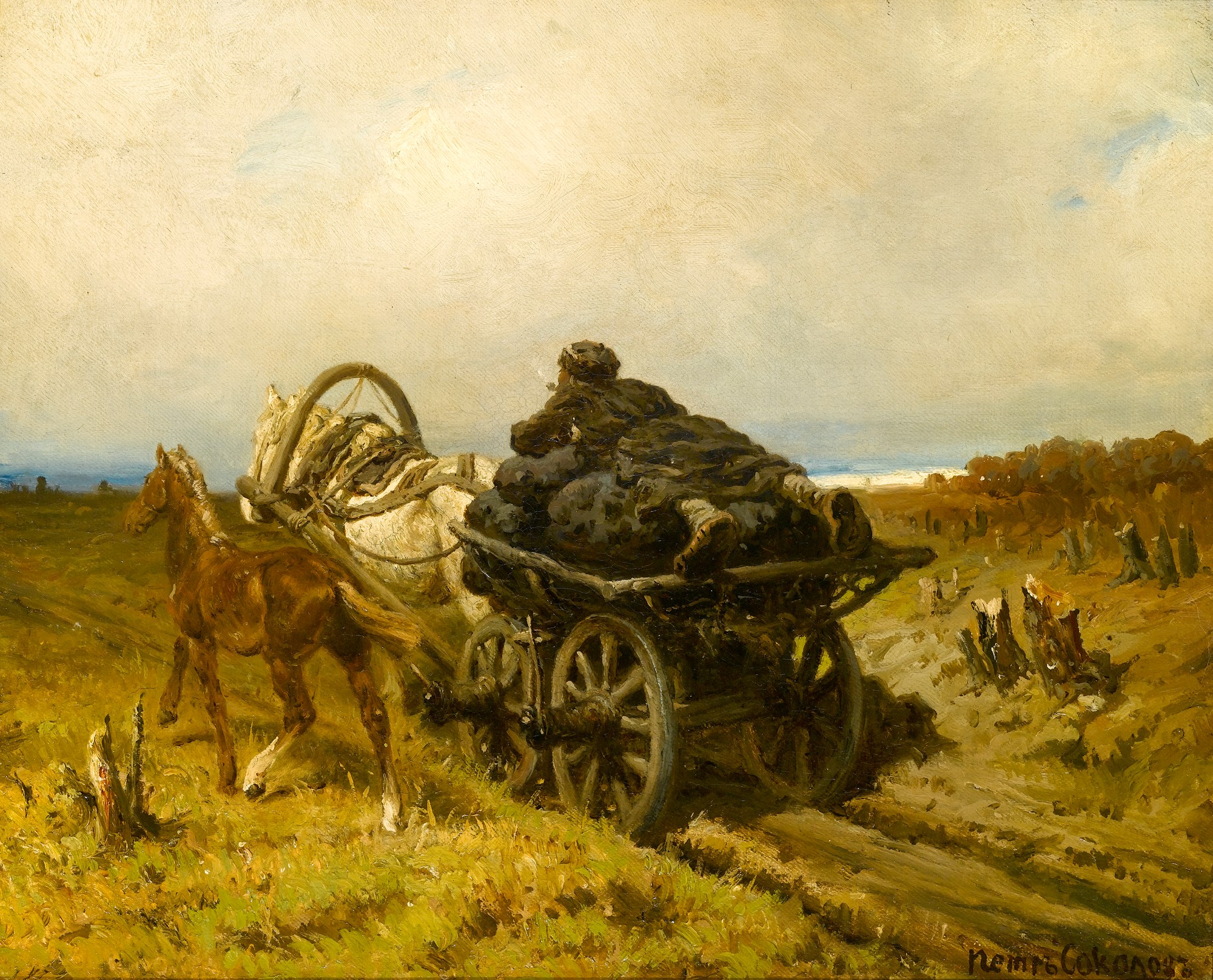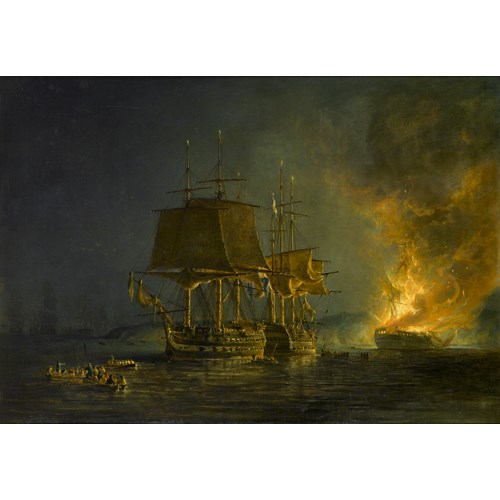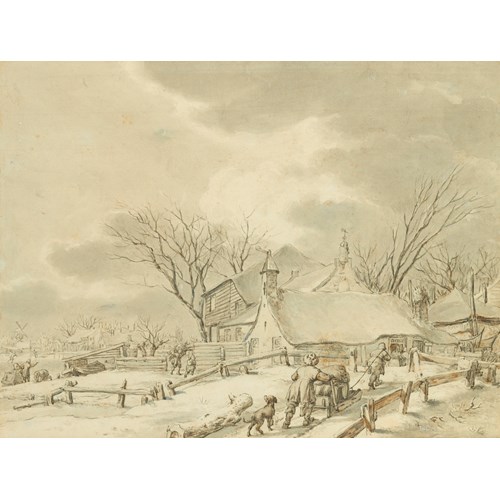Marketplace
The Journey Home
Pyotr Petrovich Sokolov
The Journey Home
Period 1850-1900, 19th century
Origin Russia
Medium Oil on canvas
Dimension 46 x 56.5 cm (18¹/₈ x 22¹/₄ inches)
A rickety cart is dragged through the stodgy landscape by a muscular gray horse. A bay colt trots alongside and, unburdened, it has a definite spring in its step. The cart itself is heavily laden, possibly with briquettes of charcoal, and on top of the sacks lies the driver. The figure is the embodiment of relaxation and he sprawls face down on his load, smoking his pipe and looking out over the expansive landscape. The terrain itself appears fairly inhospitable with the splintered remains of trees, dank and soggy ground, through which the cart has made deep ruts. Pyotr Petrovich Sokolov has rendered the landscape in a series of short sharp brushstrokes, built up in layers which helps convey the boggy nature of the ground. Similarly the haze of cloud that almost completely covers the blue sky is painted in broad painterly brushstrokes. The Journey Home is a wonderful evocation of relaxed isolation within the vastness of the Russian countryside, executed in Sokolov’s characteristic fluid and expressive style.
The Journey Home is comparable to much of Sokolov’s work. For example in his watercolour sketch Horses Drawing a Sleigh (Private Collection) he has used the same motif if a figure lying on his stomach atop a cart. Although it is only a sketch there is a similar sense of isolation in the immeasurable landscape. As Vera Pudova has said ‘The travel genre occupied a significant position in Sokolov’s oeuvre...giving us a very full impression of the lives of Russians in the second half of the 19th century wherever they concerned travel’.¹ The theme of charcoal transportation, seen in The Journey Home, is explored from a different perspective in the Tretyakov’s Beaten Track. Beaten Track is much more of a traditional landscape, with the carts animating the scene, whereas the present work is very much a genre painting. However, both works are effective explorations of this particular aspect of Russian rural life.
Sokolov was from a family of Russian artists. His father Pyotr Feodorovich Sokolov (1791-1848) was a noted portraitist, and was the first Russian master to paint portraits only in pure watercolours, a technique that supplanted the miniature portrait during the period 1820 to 1850. Pyotr Petrovich’s subtle lyricism, the delicacy of his use of colour, the lightness and vivacity of his style of painting and the sincerity of his interpretation of character all contributed to the widespread popularity of his work. He travelled widely in Russia and painted a number of sharply observed genre scenes depicting the everyday life of peasants and landowners including The Journey Home. He was also a leading book illustrator, and his illustrations for the novel Dead Souls by Nikolai Gogol (1809-1852) are especially renowned. These were executed in watercolour in the late 1880s and the 1890s and were produced in two cycles, the first in colour and the second in black and white. His interpretation of the text was intensely dramatic, sometimes verging on the grotesque, but it was also extraordinarily detailed in its observation of everyday life.
¹ Roads in Russian Art, ed. Yevgenia Petrova (exh. cat., State Russian Museum, 2004) p.50.
The Journey Home is comparable to much of Sokolov’s work. For example in his watercolour sketch Horses Drawing a Sleigh (Private Collection) he has used the same motif if a figure lying on his stomach atop a cart. Although it is only a sketch there is a similar sense of isolation in the immeasurable landscape. As Vera Pudova has said ‘The travel genre occupied a significant position in Sokolov’s oeuvre...giving us a very full impression of the lives of Russians in the second half of the 19th century wherever they concerned travel’.¹ The theme of charcoal transportation, seen in The Journey Home, is explored from a different perspective in the Tretyakov’s Beaten Track. Beaten Track is much more of a traditional landscape, with the carts animating the scene, whereas the present work is very much a genre painting. However, both works are effective explorations of this particular aspect of Russian rural life.
Sokolov was from a family of Russian artists. His father Pyotr Feodorovich Sokolov (1791-1848) was a noted portraitist, and was the first Russian master to paint portraits only in pure watercolours, a technique that supplanted the miniature portrait during the period 1820 to 1850. Pyotr Petrovich’s subtle lyricism, the delicacy of his use of colour, the lightness and vivacity of his style of painting and the sincerity of his interpretation of character all contributed to the widespread popularity of his work. He travelled widely in Russia and painted a number of sharply observed genre scenes depicting the everyday life of peasants and landowners including The Journey Home. He was also a leading book illustrator, and his illustrations for the novel Dead Souls by Nikolai Gogol (1809-1852) are especially renowned. These were executed in watercolour in the late 1880s and the 1890s and were produced in two cycles, the first in colour and the second in black and white. His interpretation of the text was intensely dramatic, sometimes verging on the grotesque, but it was also extraordinarily detailed in its observation of everyday life.
¹ Roads in Russian Art, ed. Yevgenia Petrova (exh. cat., State Russian Museum, 2004) p.50.
Period: 1850-1900, 19th century
Origin: Russia
Medium: Oil on canvas
Signature: Signed in Cyrillic (lower right).
Dimension: 46 x 56.5 cm (18¹/₈ x 22¹/₄ inches)
More artworks from the Gallery





 A Woman Bending forwards in Work, and_T638856835938571470.jpg?width=500&height=500&mode=pad&scale=both&qlt=90&format=jpg)
 and Other Sketches of Various Characters (verso)_T637904672381408978.jpg?width=500&height=500&mode=pad&scale=both&qlt=90&format=jpg)


